#Scarlet milkweed
Explore tagged Tumblr posts
Text
A Tropical Milkweed

A Tropical Milkweed (Asclepias curassivica) hosting a couple of ladybug visitors in the Japanese Garden. Photo credit: Eleanor Chua.
This milkweed is apparently a native of Mexico and tropical America. Interestingly, many native insects beside the ladybugs were hanging around the few shrubs, including a Plain Tiger that was laying eggs all over them.
#photographers on tumblr#Asclepias curassivica.tropical milkweed#canon eos rp#canon photography#flora fauna#flora photography#flower pics#ladybug#scarlet milkweed#tamron 16-300mm
50 notes
·
View notes
Text

Asclepias curassavica / Tropical Milkweed at the Peace River Botanical & Sculpture Gardens in Punta Gorda, FL
#Asclepias curassavica#Asclepias#apocynaceae#Tropical Milkweed#Bloodflower#Mexican butterfly Weed#Scarlet milkweed#Milkweed#Plants#Flowers#Nature photography#photography#photographers on tumblr#Peace River Botanical & Sculpture Gardens#Peace River#Punta Gorda#Punta Gorda FL#Florida#🌺🌻
5 notes
·
View notes
Text

Sketchbook snippets!! I'm working on like four projects at once right now and they are all due in the next two weeks and I might die but that's okay bc I get to paint acorns.
#my art#illustration#sketchbook#wip#colored pencil#botanical art#plant art#silky dogwood#swamp thistle#scarlet oak#sundial lupine#poke milkweed#wild seed project
29 notes
·
View notes
Text
Some of you may have heard about Monarch butterflies being added to the Threatened species list in the US and be planning to immediately rush out in spring and buy all the milkweed you can manage to do your part and help the species.
And that's fantastic!! Starting a pollinator garden and/or encouraging people and businesses around you to do the same is an excellent way to help not just Monarchs but many other threatened and at-risk pollinator species!
However.
Please please PLEASE do not obtain Tropical Milkweed for this purpose!
Tropical milkweed (Asclepias curassavica)--also commonly known as bloodflower, Mexican butterflyweed, and scarlet milkweed--will likely be the first species of milkweed you find for sale at most nurseries. It'll be fairly cheap, too, and it grows and propagates so easily you'll just want to grab it! But do not do that!
Tropical milkweed can cause a host of issues that can ultimately harm the butterflies you're trying to help, such as--
Harboring a protozoan parasite called OE (which has been linked to lower migration success, reductions in body mass, lifespan, mating success, and flight ability) for long periods of time
Remaining alive for longer periods, encouraging breeding during migration time/overwintering time as well as keeping monarchs in an area until a hard freeze wherein which they die
Actually becoming toxic to monarch caterpillars when exposed to warmer temperatures associated with climate change
However--do not be discouraged!! There are over 100 species of milkweed native to the United States, and plenty of resources on which are native to your state specifically! From there, you can find the nurseries dedicated to selling native milkweeds, or buy/trade for/collect seeds to grow them yourself!!
The world of native milkweeds is vast and enchanting, and I'm sure you'll soon find a favorite species native to your area that suits your growing space! There's tons of amazing options--whether you choose the beautiful pink vanilla-smelling swamp milkweed, the sophisticated redring milkweed, the elusive purple milkweed, the alluring green antelopehorn milkweed, or the charming heartleaf milkweed, or even something I didn't list!
And there's tons of resources and lots of people willing to help you on your native milkweed journey! Like me! Feel free to shoot me an ask if you have any questions!
Just. PLEASE. Leave the tropical milkweed alone. Stay away.
TLDR: Start a pollinator garden to help the monarchs! Just don't plant tropical milkweed. There's hundreds of other milkweeds to grow instead!
#milkweed#monarchs#monarch butterfly#pollinator garden#pollinator gardening#outdoor gardening#gardening#flower gardening#out of queue#ani rambles
19K notes
·
View notes
Text
Moon 602
Season: Newleaf
Overarching Events
Not enough medicine cats
Deaths
Maybe it's surprising to some cats. it doesn't feel like it should be, Cinderstar is so sure they want Frosttooth as their mate, and Frosttooth loves them just as much in return. However, a few days later and despite StarClan's efforts, Cinderstar's body just couldn't continue. Their remaining lives were taken by old age. They are sent to the Dark Forest for the murder of their child and a blatant disregard for the warrior code
Frosttooth can hardly process the sight of Cinderstar;s body and is grief-stricken Copperlake and Chervilthroat grieve but are not stricken

Ceremonies
Spikestar has received their nine lives and has become the new leader of PikaClan. they feel they are not ready for this new responisbility, but will try their best to do what is right for the Clan

Spikestar chooses Clawlightning to take over as deputy

Time has taken its toll and Growlithe has noticed themself slowing down. They have worked timelessly for many moons, but it is time for them to retire

Health
Chervilthroat's joint pain abated Wildmask got a running nose Milkweedshine got a running nose Freezequake's infection abated Bansheeflood got a running nose Snowpaw got a running nose Scarletpaw's bruises healed but overdid their last training session and got bruised again
Patrols

It starts snowing as the patrol sets out for fresh-kill. The prey must be hiding and a snowstorm descends into the patrol
Charvilthroat got: shivering

The patrol is ambushed by a groupt of rigues. Taken by surprise, the patrol scatters and loses cohesion. The rogues are quick to take advantage of the confusion and the patrol retreats, basilpaw badly wounded
Basilpaw got: claw-wound
#pikaclan#moon 602#cinder#frost#spike#claw#growlithe#copper#chervil#wild#milkweed#freeze#bandhsee#snow#scarlet#rogues#basil
0 notes
Text
Milkweed Lovers Everywhere, Heed My Warning
By all means let me know if I'm wrong here, but if I'm not wrong then we're looking at a serious (at least to me) problem.
I've been trying to stray away from Tropical Milkweed (Asclepias curassavica) and towards more native species in my area--things like swamp, sandhill, etc--and Butterflyweed (Asclepias tuberosa) fits in that category for me. It's hard to find native milkweed plants in stores--even places I've gone to in the past that had a handful of native species are currently only selling Tropical Milkweed. Even still, I know that there's been a good bit of buzz around growing native species, and some stores I've visited have said they're trying to find vendors with native species--they're not only selling Tropical for lack of trying.
So imagine my surprise--and delight--when I go to Lowe's and see Asclepias tubersoa blazoned on a plant label!
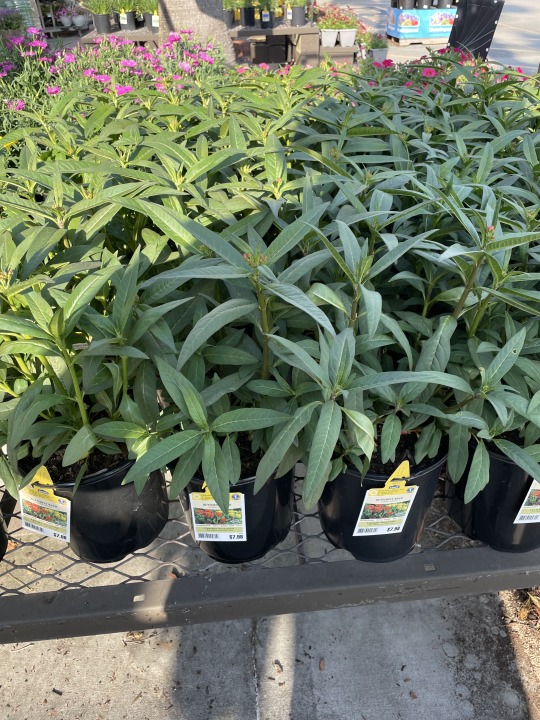
And imagine my surprise when it's being sold right next to Tropical Milkweed and looks almost identical to it.
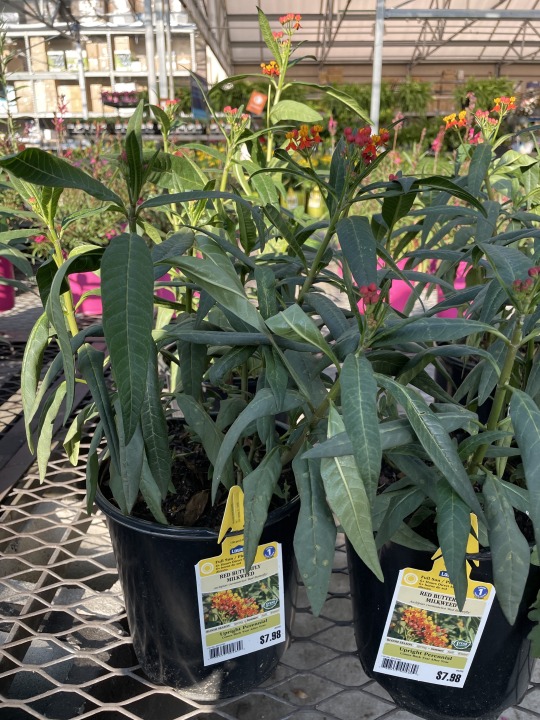
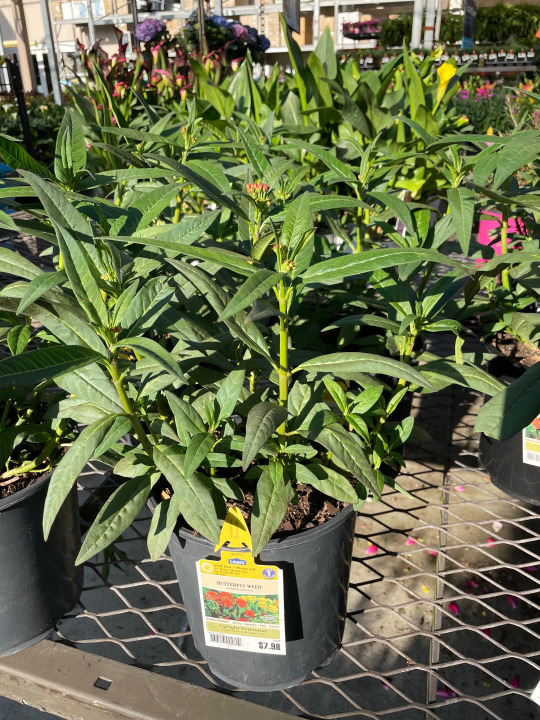
I was immediately suspicious--especially considering the red flower buds on the 'Butterfly weed'. I've grown Tropical Milkweed for several years, and while it's been awhile since I've seen a Butterfly Weed plant outside of a photograph, these definitely didn't look like what I'd seen. Not to mention, I'd only heard of Asclepias tuberosa flowering in orange or yellow--not red. Of course, at the same time, I'm not a professional botanist, and a quick google search did declare that butterfly weed can grow in red (though the images all look like asclepias curassavica to me...).
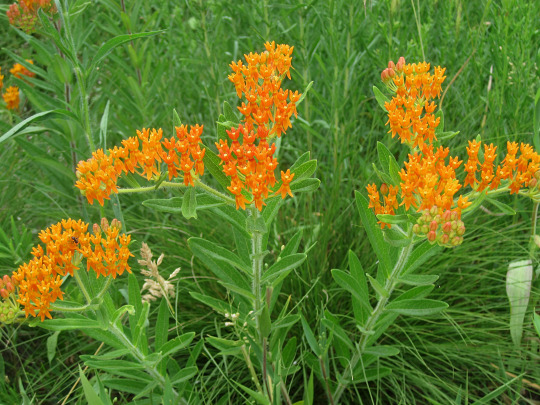
(Image from the Native Plant Database. Looking at this picture, I should've realized where this was going sooner...)
So I did the reasonable thing and bought two of them. I figured if the red buds somehow turned orange and were actually Butterfly Weed, then I'd be perfectly satisfied. If they turned out to be Tropical Milkweed, well, I simply would give them to my neighbor who's fond of them, or find something else to do with them.
(I feel the need to emphasize; there are a lot of people online who are in the 'if you plant tropical milkweed you're a horrible person and intentionally killing monarch butterflies' camp. I am not one of them; it's not invasive in my area of Florida, it just takes a little bit of extra managing in terms of cutting it back in October/November.)
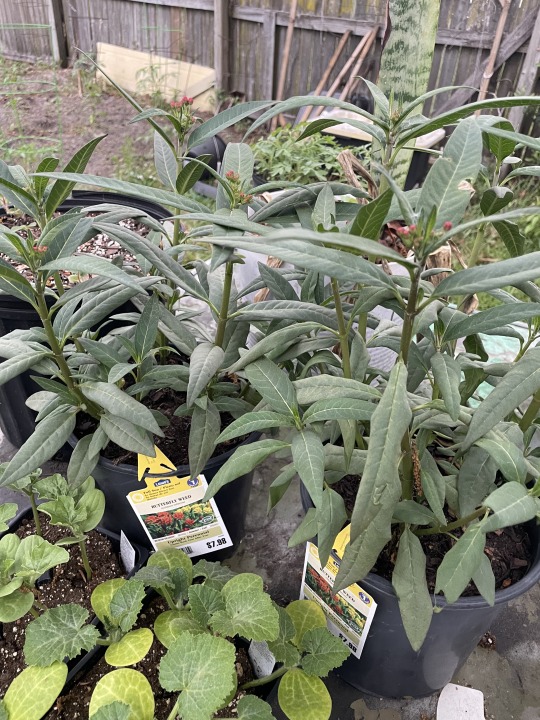

I ended up in the same Lowe's again today, shopping for my mom, and took a peek at their plant selection. Lo and behold, I found the Butterfly Weed, and...

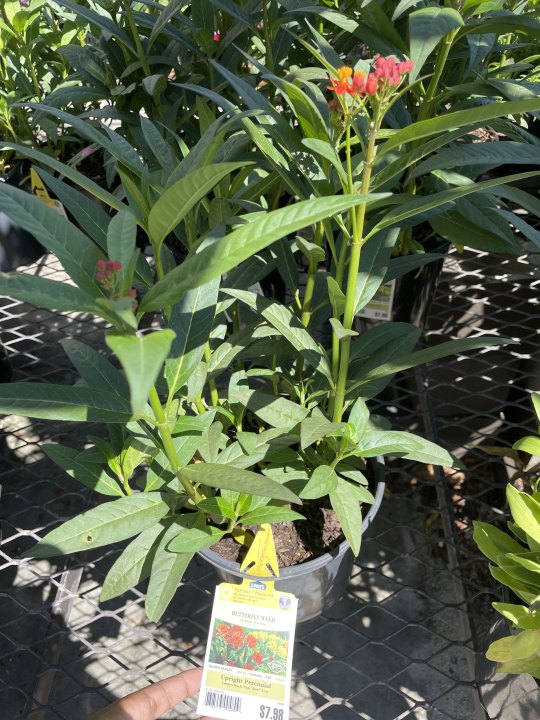
This sure does look like Tropical Milkweed to me, and to others in my gardening server, yet it's still labeled as 'Butterfly Weed.' Also, I didn't see any Tropical Milkweed on any of the shelves--at least, nothing labeled as Tropical Milkweed. Instead, all I saw was Tropical Milkweed disguised as Butterfly Weed.
This is, in my humble pollinator garden enthusiast opinion, a problem. At best, Lowe's--or the company they source their plants from--is mislabeling their plants on accident. Which could cause problems if people are buying the plants and putting them in a place that's not quite the right condition for them, or create severe disappointment if someone's excited to grow the native Asclepias tuberosa only to end up with something else entirely. At worst? Lowe's--or the company they source their plants from--are aware that people want to grow native milkweed and are either unable to or too lazy to grow them, and would rather try to get away with selling Tropical Milkweed--which has been growing increasingly controversial in some gardening circles--and still reap the benefits and profits of selling native milkweed species.
However, I'll be real? I'm not sure what exactly to do about it. So I guess I'm just letting everyone know; if you see 'Butterfly Weed (Asclepias tuberosa)' in your local Lowe's, at least double check. Otherwise, you may plant Tropical Milkweed/Scarlet Milkweed (Asclepias curassavica) instead.
#milkweed#gardening#flowers#pollinator gardening#pollinator garden#Lowe's#tropical milkweed#butterfly weed#asclepias curassavica#asclepias tuberosa#outdoor gardening#flower gardening#ani rambles#out of queue#idk how legible this post is but I hope its at least SOMEWHAT legible yknow?
938 notes
·
View notes
Text
Ipomoea - Intro


"Milkweeds... At least you're actually good at stalking..."

He/him - Mixed Native American - 5'5
Looks: Fairly thin, though he's a bit pear shaped with very powerful legs. His eyes change depending on the au, at base they are purple and almond shaped. Lighter tan skin, he has a birthmark on the right side of his hips that is a sort of blobby floral shape. He has a small, upturned nose and fairly thin, dry lips. His hair is the longest, black and going down to his mid-thighs when it's down, he usually keeps it in a loose or messy bun. At base, he's always shaking when you touch him and usually very warm from having been running from you. His skin is not the healthiest as he's constantly stressed, once he gets used to it his skin will become softer and brighter.
His base is terrified of you and actively dislikes you, always running to escape you. He resents morning glories for their meanings and what that can reflect on him. Ipomea Alba is a stark contrast from his base form, Alba is deeply in love with darling and views his relationship to darling the same way Belphie views her relationship Alba's eyes are extremely pale, almost white. Ipomea Batatas is similar to his base form, but much more passive, he gives in to his darling's wishes very quickly. Ipomea Coccinea is a woman, she is also a complete bitch, she kinda slays cuz she's a major girlboss but she's such a mean girl it kinda negates her cool factor, her eyes are scarlet. Ipomea Cordatotriloba is here for angst, either having an extremely aggressive darling who traps him and abuses him or having a dead darling, he's much more lightskinned and his eyes are a dusty pink. Ipomea Jalapa is a top so not real, this blog is not for that, dw, he doesn't exist, he can't hurt you. Ipomea Lobata is for crackfics, his eyes are a reddish orange. Ipomea Quamoclit is like Coccinea if she wasn't mean, Quamoclit is a girlboss and a sugar mommy, emphasis on the mommy, she's a sweetheart with light red eyes. Technically Ipomea's base last name is Purpurea.
Ipomea is the only one of my characters who knows about flower meanings, that's why he favors milkweeds and despises morning glories. He will cry if you give him morning glories, doesn't matter what version, he'll be so sad. Sweet potatoes are his favorite food, though.
Flavor profile: The different versions have slightly different flavors, but it doesn't change too much about how you should prepare him. He should be cooked like a suckling pig to draw out the sweet flavors within, be careful not to under or over cook him or he will be bitter and impossible to truly enjoy. Serve him on a bed of fruits with a simple glass of water or something with a very neutral flavor as to not overwhelm your tastebuds. Ipomea Lobata is the only one with a different ideal preparation, grind his meat to make burgers with, they'll be the sweetest burgers you ever have.
Hornt time:
Ipomea is actually majorly into the whole predator/prey thing you usually have going on. He's way too stubborn and scared of you to ever admit it, but he often has wet dreams centered around it. He's the least sexual of my ocs as he is genuinely scared of his darling and genuine fear is pretty unsexy to me. However, if you get him to actually accept living with you and not trying to run away, he will gain the highest libido ever. Like you come home and he's immediately pulling your pants down levels. Once he's accepted you, he's really so desperate for the attention.

14 notes
·
View notes
Text
🌿Headmates' favorite flowers🌿
Andrina: Flytrap Anemone
Arouran: Lavender
Bee: Common Daisy
Bones/Barren: Bat Orchid
Chorus/Hymn: Yellow Angels Trumpet
Clown: Flying Duck Orchid
Cog/Coyn: Angel Amber Kiss Pansy
Conundrum: Coral Hibiscus
Dani: Lambs Ear
Daphne: Black Magic Petunia
Darlene: Miss Scarlet Climbing Rose
Faun: Green Hellebore
Fernn: White Delight Hybrid Tea Rose
Fidget: Tree Fuchsia
Firyn: Chocolate Calla Lily
Fizz: Matchstick Chrysanthemum
Florence: Fruit Punch Carnation
Gir: Black Tree Aeonium
Gizmo/Gadget: Titan Arum
Gus/Gully: Starflower
Irvine: Yellow Toadflax
Junie/Junebug: Blue Forget Me Nots
Lady: Sweet Akito Rose
M0NST3R: Akai Ryu Venus Flytrap
Margo: Mountain Stone Parsley
Moc/Marc: Common Milkweed
Peachy: Strawberry Blonde Sunflower
Roach: Black Kangaroo Paw
Torrin: Crackerjack Marigold
Walker: Madame Butterfly Red Snapdragon
Whisp: White Moon Flower
Zac/Bravo: Copper Bronze Spider Mums
Zee/Zephyr: Deep Pink Wax Flower
Zero/Echo: Nikko Blue Hydrangea
#did alter#alter info#alters#alterhuman#alternative#did community#did system#system info#traumagenic system#system stuff#plural system#system#floral#flowers#flora and fauna#alter preferences#alters' favorite flowers#💐#🌸#🏵#🌹#alter intro#🌺#🌻#🌼#🌷#🪻#⚘️#🌿#💮
5 notes
·
View notes
Text
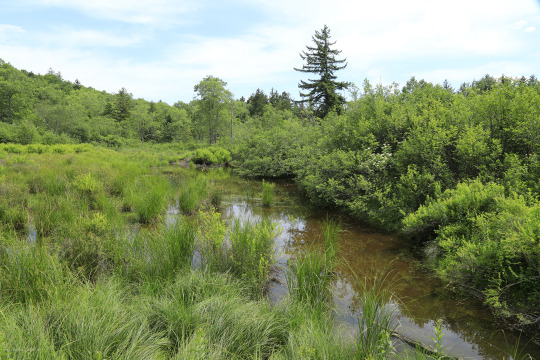

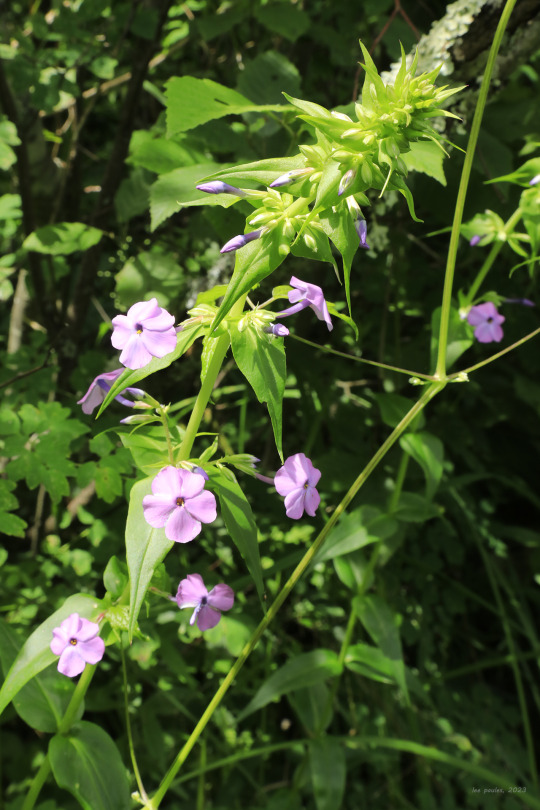

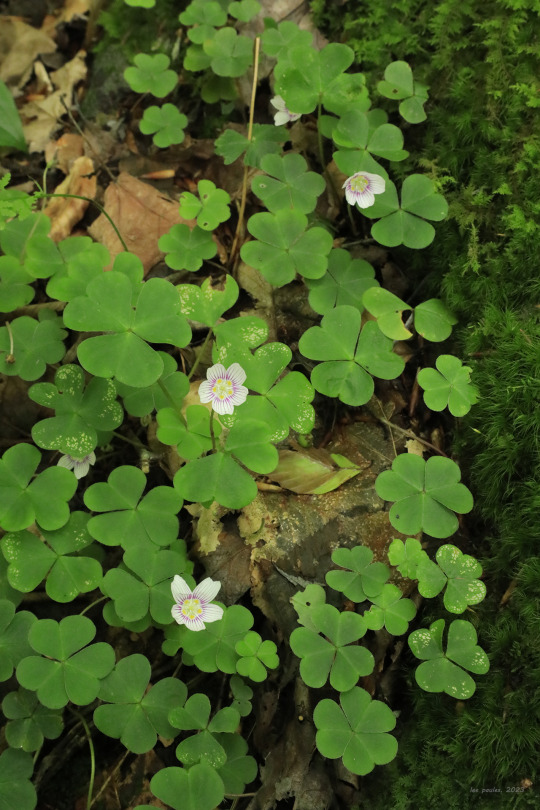

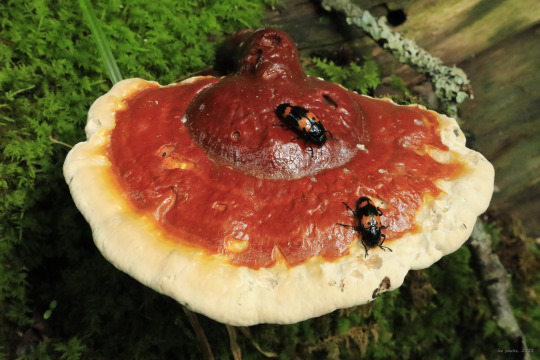
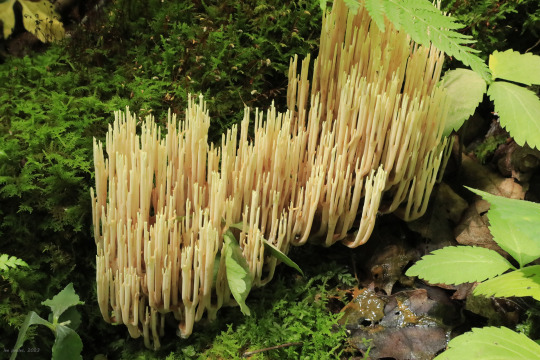

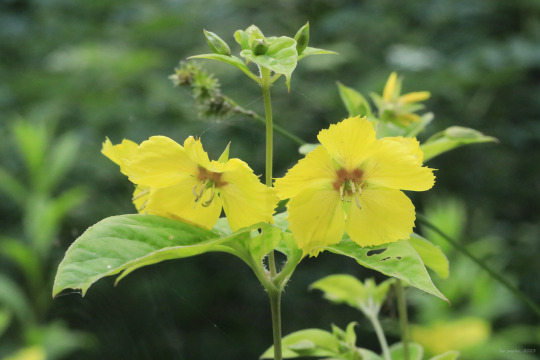
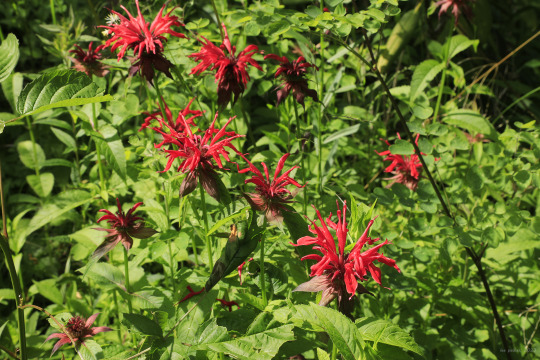
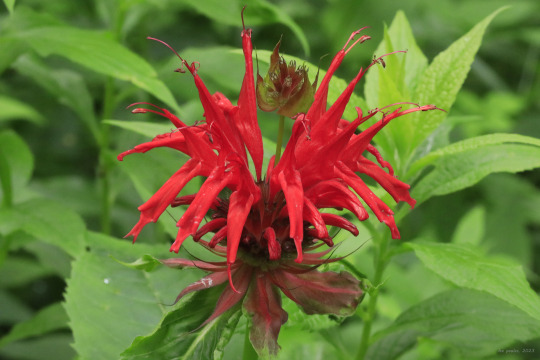
Part 2: Early Summer Wildflower Palooza, Cranberry Glades. During the first week of July, as the orchids are peaking in the bogs and seeps, the first wave of summer wildflowers, including the milkweeds and beebalms, arrives in earnest, bringing a blaze of color to open meadows and bog and forest margins. In the old growth woods of the adjacent Cranberry Wilderness, an array of strange and beautiful fungi sprout from moss-covered logs and the forest floor.
From top: tall meadow rue (Thalictrum pubescens), also known as king of the meadow, a wetlands-loving perennial whose distinctive, cream-colored flowers are composed of thread-like stamens only; meadow phlox (Phlox maculata), also known as wild sweet William and spotted phlox, easily distinguished from other phlox species by its red-spotted stems; mountain wood sorrel (Oxalis montana); a ramp (Allium tricoccum) flower, which emerges in early summer on a leafless stalk, after the foliage has died back; a shiny hemlock varnish shelf (Ganoderma tsugae) assailed by pleasing fungus beetles (Megalodacne), rarely seen because they hide under leaf litter during the day and feed on Ganoderma fungi at night; a lovely colony of crown-tipped corals (Artomyces pyxidatus); the beguiling fringed loosestrife (Lysimachia ciliata), an aggressively-colonizing perennial that makes for a shady ground cover in native wildflower gardens; and that blazingly-beautiful mint, scarlet beebalm (Monarda didyma), whose storied history as a medicinal herb stems from its antiseptic and stimulant properties.
#appalachia#vandalia#west virginia#wildflowers#allegheny mountains#flora#early summer#cranberry glades#monongahela national forest#fungi#insects#beetle#pleasing fungus beetle#tall meadow rue#king of the meadow#meadow phlox#wild sweet william#spotted phlox#mountain wood sorrel#ramp#wild leek#hemlock varnish shelf#crown-tipped coral#fringed loosestrife#scarlet beebalm#oswego tea
89 notes
·
View notes
Text
Flower Friday
Flower Power Friday? Friday flowers? I don't remember. But here, @a-noble-dragon these are for you.






None of these are actually my flowers, but I have a new app and I have been obsessed with identifying plants everywhere I go lately. You should try it—it's called Seek.
I think these are a broad-leaved sweet pea, an elegant zinnia, the common sunflower, a scarlet sage, the alpine aster, and narrowleaf milkweed.
Tagging people who might like flowers: @jamilas-pen @dytzyone @mammameesh @flowertrigger @ramonaflow
@leofdaeg-sand @tyfinn @mostlyinthemorning
15 notes
·
View notes
Text

Today's the last day of meteorological summer, so although we will stay hot here in Texas for some weeks to come, I feel like it's time to start posting the plants that got through the heat with flying colors. This is a young seed-grown Anacacho orchid tree (Bauhinia lunarioides), a species with very limited and patchy distribution from southwest Texas into Mexico. I grew it via the sophisticated technique of swiping seeds off a public landscaping tree and throwing them in this pot, which is an absolute mess. There's an agave and an incredibly spindly zizotes milkweed in here, the latter seedgrown ; there was a seedgrown scarlet muskflower in here too, though I haven't seen it in a bit. Rose 'Martha Gonzales' is sneaking into frame from an adjoining pot. All of these plants do exceptionally well in extreme heat and dry conditions (with periodic deep watering). Once we actually do cool down enough to transplant safely, I'll be taking them all out and repotting them less chaotically.
38 notes
·
View notes
Text
Richard and Helen—'Dancing in the Minefields'
He took her hand and they danced on the lawn, barefoot, laughing, and he always remembered how her face shone in the sunlight that reflected off their left hands, how Mother and Father joined them in the spin and dip and sway, how the flowers seemed to sing.
(And we went dancing in the minefields)
She remembered how he held her the first time, tears not enough to wash away the scarlet that smeared her vision, skin and clothes scrubbed clean, but she was scraped out raw, a piece of her very heart torn away, and there was only pain. Still he held her, held her strong and soft, tears on her shoulder, and they swayed with the grief of it all, a broken kind of dancing in the darkness.
(We went sailing in the storms)
They laid Father away into the black earth, and after the wake, after the hugs and the handshakes and the teary words faded out the door, they sat in the quiet kitchen, listening to Mother sing herself to sleep, a wavering hymn of hope. She told him then, in the quiet of a fire crackling and tea cups, why she'd ducked out of the service twice, told him hushed and almost fearfully, but he heard a louder song, something bright and brave, and he found himself laughing through tears. He pulled her to him, and they turned, stepped, swayed, falling into the rhythm of the song drifting from the broken heart upstairs. It made no sense to dance into the night, not after three little mounds in the garden had been joined by a bigger one in the graveyard. But when he held her, he thought he could feel it, the flame of life lit inside her womb, a beacon in the dark, and so they danced in memory, and in hope.
(And it was harder than we'd dreamed)
She remembered rocking a wee curl of baby girl in her arms, the crying louder than her song, and her anger desperation burned against the backs of her eyes, but when she looked up, she saw him, boy-child splayed across his chest in golden-haired bliss, and his grin melted something cold out of her stomach. Children in hand, they came together, matched steps and rhythm, a slow waltz around the nursery, until she had to stop singing for laughing, and the baby fell silent.
(But I believe)
They put the gramophone on one night, after supper, and the children laughed and spun around them like milkweed seeds in a breeze. He laughed into her ear as sons and daughters giggled and fell over on the rug, and she kissed him hard, until they stopped dancing.
(That's what the promise is for)
It was the 3rd of September, a Sunday night, and there were school trunks standing round the living room, and half-empty dishes on the table, when he took her hands, and she realized they were shaking. Instead of speeches or news reports, a quiet song came over the wireless as he drew her away from the dining room, from the pale, wide-eyed stares of the four she had prayed would never have to see such a day.
"Dance with me," he whispered, and she could only nod, holding on for dear life, as they danced into the day of war.
#at the table lucy climbed into peter's lap and whispered 'can we dance too?'#so peter danced with his baby sister. ed finished his pudding. and susan got up to start clearing the dishes.#none of them ever forgot that night. when their parents danced in spite of everything#mr pevensie's dad was 'william peter' but he went by his middle name so they switched it around for pete#the song is 'dancing in the minefields' by andrew peterson#richard pevensie#helen pevensie#narnia fanfiction#my writing#narnia movies#narnia
7 notes
·
View notes
Note
favorite flowers?
-We answered a question like this before, didn't we?
-Yep yep! Over here!
-Hey, but, mom only got a lil' bit of that post! Hey! Mom! Talk more about flowers!
-Oh, sure!
-I suppose I'll talk about easy flower things... so.... my name! Clematis is a type of climbing plants, their name being greek for "climbing flower"! Isn't that neat? Another name for the flower is "traveler's joy," since they often grow on structures. Some species can actually be quite the pests, since they grow so fast. The one I wear is a lanuginosa, also known as a Nelly Moser!
-Yeah, but is it your favorite?
-Oh! Well, that's a different question, dear.
-It's certainly a flower I enjoy, that's for sure. I wouldn't call it a favorite though.
-Last time, you mentioned orchids, but thats because of the emotional journey or something. What about a flower you like for a normal reason?
-Hmmm... For normal reasons.... maybe the Mexican Butterfly Weed. It's also known as the blood flower or scarlet milkweed! The actual flowers that bloom on them are rather small, but I find them very elegant. They're also very important to monarch butterflies, so they invite some very beautiful guests to my garden!
-I'm also appreciative of snowdrops. Once I...
-...
-One of the first gifts I gave your father was a bouquet of snowdrops and lily-of-the-valley. It was our first date, and he plucked one of the flowers from the bunch and put it in my hair. After that, I started putting flowers in my hair more often.
-... Hm.
#project moon ask blog#project moon rp#💐; of thorns and roses#fixer oc#roleplay blog#oc roleplay#ask blog
4 notes
·
View notes
Text
Tropical Milkweed, Its Problems, and What To Plant Instead
I am writing this to atone for the sins of my past (handing out tropical milkweed cuttings to my friends and teachers before I knew better).
(Also let me make this clear I am Floridian I am writing this from the perspective of someone in the United States if you live in Tropical Milkweed's native range this doesn't apply to you go forth pogchamp)
Look online, on TV, in books, in newspapers, left, right, up, down, anywhere, and you'll see people talking about how planting milkweed is crucial, essential for the survival of monarch butterflies. Milkweed is the only plant that monarch caterpillars can eat as they're growing, and the loss of it in our wild spaces is one of the most direct links to the ecological extinction speedrun of not just monarchs, but dozens of other insects who rely on its abundance of nectar-filled flowers to survive. You'll be urged to run, not walk, to your nearest garden center, buy as much milkweed as you can, and hurry fast to plant it in your gardens and be part of the solution, not the problem. The issue is that, oftentimes, the milkweed you leave the store with is a vibrant red and orange, with pointed green leaves, dozens like it lining the shelves across stores all over the nation...
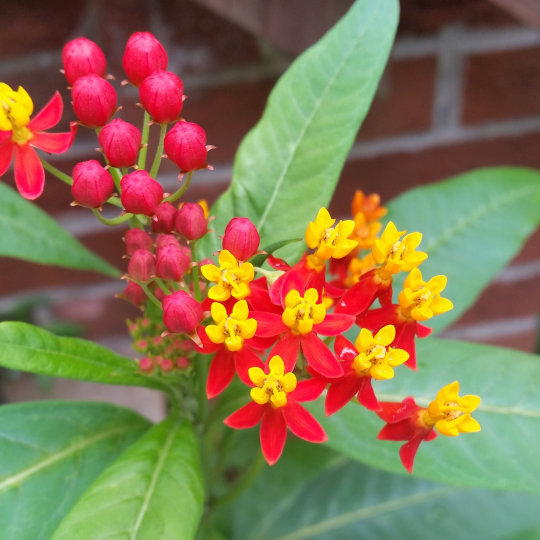
Tropical milkweed. Scarlet milkweed. Bloodflower. Mexican butterfly weed. Asclepias curassavica. This plant is a being of many names, and our culprit of the hour.
'Culprit? Culprit of what?' Culprit of enticing people to buy it under the guise of helping, only to possibly cause more harm than good.
Let's discuss.
Tropical Milkweed (Asclepias curassavica) is a gorgeous milkweed (especially the yellow variety? ooh, that had me in a grip as a teen) that's easy to obtain--too easy. It lines the shelves of stores like Walmart, Lowe's, Home Depot, and even hundreds and dozens of smaller garden stores, and is sold for reasonably cheap because its quick and easy to grow from seed and eagerly roots from cuttings. It's extremely popular with butterflies too--in many scenarios, Tropical Milkweed will be preferred as host plants over other related species like Butterflyweed (Asclepias tuberosa), and its also popular with other species of butterfly, bees, and wasps as a nectar source. It lasts well into winter in some areas of the United States, is quick to regrow when cut back, and doesn't die back for periods of the season like some other milkweeds do. It's eager to reseed, creating capsules with tens of dozens of seeds and scattering across the winds with the help of little silky parachutes much like the ones dandelions are known for.
'Ani, what's the problem with that? This all sounds like its great for monarchs!'
See, here's the kickers. In fact, here's several kickers. Here's an entire mollywhopping of kickers.
OE Infections
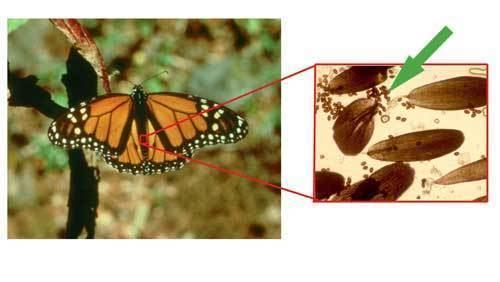
In the temperate areas that it doesn't die back over winter (or even, in some cases, where it doesn't die back during the season like other milkweeds), it can become a host for OE. OE is short for Ophryocystis elektroscirrha, and its a protozoan parasite that can and frequently does infect monarchs. As infected monarchs visit different plants--whether its to drink nectar, to lay eggs, or even just doing a fly-by of the garden--they drop spores from their wings that can then fall onto the leaves, flowers, and even any eggs already on the plant. As caterpillars hatch and begin to eat the plant, they ingest the protozoan, which begins the cycle anew. High OE levels in adult monarchs have been linked to lower migration success, reductions in body mass, lifespan, mating success, and flight ability. And that's if the caterpillars don't succumb prematurely to the infection, or if they're able to even exit their cocoon and fly once they finish pupating--deformed wings are frequently a result after infections. Now, OE is a parasite that's evolved alongside monarchs--and monarchs are usually able to handle an infection just fine, but if they're carrying a high load? That's where the problem lies.
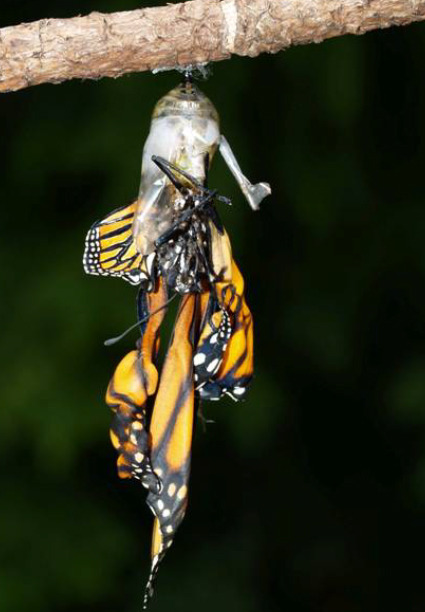
What role does tropical milkweed play in this? Most milkweeds die back after blooming, at least once or even twice per season--and the parasite dies alongside them. As native milkweeds push out fresh foliage, its parasite-free, offering a healthy new buffet for caterpillars. Tropical milkweed... doesn't do that. If nothing's done, (at least in my state of Florida) tropical milkweed will stay fresh and green all the way up until the first real frost hits way in December--and that's if there's a hard frost, when you travel farther south. And during all that time, OE levels are building up on the leaves, so any future caterpillars that feed on this plant are doomed the instant their egg is laid on a leaf.
Its not that it's utterly impossible for a monarch to get infected with OE on any other kind of milkweed--monarchs are known for their traveling habits, and the chances of them happening upon a different milkweed plant than the tropical milkweed in your backyard is pretty high. But whereas native milkweeds die back and essentially reboot their system with fresh, disease-free leaves at least once a season, tropical milkweeds are like downloading a virus onto a USB and then passing it to your friends.
But that's not all, either. Time for kick 2.
Migration Interruption

Sit with me a moment and imagine you're a monarch butterfly. You're hardwired to know that as your food source starts dwindling at home, its time to get a move on and fly on down to the family's vacation home in Mexico for the winter. The buffets shut down, you exit stage left. But on your way to what's essentially a season-long smorgasbord with friends, you find... a buffet is still open. You're supposed to leave when the buffets are shutting down, but this one's up and running, lights are on, and plenty of people are there having fun, so you step in to relax. You'll take your trip later.
Now imagine a bit after you entered that buffet, the staff stuffed the guests into the walk-in freezer, locked the door, turned off all the lights, locked up the building, and left.
That's basically what tropical milkweed being 'evergreen' is doing to monarch butterflies in the fall and winter seasons. In areas up north where it can stay growing far later into the fall/winter months--or worse, in the south, where it can basically be evergreen until a hard frost (if one even happens), it can interrupt the monarchs' iconic migration cycle. They'll stay in place and continue breeding, living life like they aren't supposed to be a country away--until a frost hits, and they're dead in a snap. And if there's not a frost, you're getting a bunch of OE spore-ridden monarchs flying around a bunch of OE spore-ridden milkweed plants that the butterflies who followed the rules and overwintered in Mexico are gonna be returning to. POV you're starting a family in a house so laden with asbestos and black mold that there's practically black dust floating around.
This is already pretty bad. Can it get worse? Absolutely. Kick number 3.
It's Pretty Invasive (in the US)
It's fast growing, its eager to go to seed (so eager that it can flower and produce seed at the same time), its growing all throughout winter--which would be great, if it were native to the United States. Unfortunately, it isn't! As one could imply from the name, Mexican butterfly weed is native to--well--Mexico, as well as the Caribbean, South America, and Central America.
Further North into the states, and it's more of an annual--a plant that lasts maybe a year tops, dies back permanently, and you go buy more next year, or start from seed. Further south? It's a perennial, baby--which means its got even more time to spread its seeds and really thrive in the warmer climates of places like Florida, Texas, California, etc. Not to mention, as climate change makes temperatures rise, places where tropical milkweed is an annual may quickly begin seeing it stand strong all year...
I won't pretend to be a Professional Milkweed Identifier. I'm getting better at it with time, but I'm not a pro. But most of the time I go outside and I go 'oh, that's a milkweed!' its tropical milkweed. I've seen it grow in the sidewalk cracks of a gardening store I go to--its a clean four feet tall, always flowering, always making seeds. Tropical Milkweed is eager to escape the confines of your backyard, or make more plants in your backyard--I started with 5 plants one year, and the next year I had seven, then twelve, and that's just the ones that didn't get mowed over in the seedling stage...
But wait, that's not all! Kick number 4, baby!
Toxic to Monarchs????
According to the Xerces Foundation, emerging research suggests that tropical milkweed may become toxic to monarch caterpillars when exposed to the warmer temperatures associated with climate change.
'What the fuck, I thought milkweed was good for monarchs! How the hell does that happen?!'
All milkweeds produce cardenolides in their sap--a type of steroid that are toxic to most insects (and even people). Milkweeds create it to repel herbivores that would munch on it otherwise--except for milkweed butterflies (Danainae family), like our legendary monarch, as well as the queen and plain tiger butterfly. Larvae eat up milkweed leaves like there's no tomorrow, to stock up on those cardenolides and become toxic to their vertebrate predators--except for a few species that have evolved to become cardenolide-tolerant (black-backed orioles and black-headed grosbeaks). But, when cardenolide concentrations are high enough, it's too strong for even monarch butterflies to withstand--they die because of the very plant that's supposed to give them life. Kinda fucked up. Comparatively, many native species have lower cardenolide levels--and don't immediately go into flux at higher temps like tropical milkweed does.
'Wait, Ani, if there's all these problems with tropical milkweed, why is it sold everywhere?'
Capitalism. The answer is capitalism.
Well, actually, its a bit more complicated than that but it's also still capitalism.

The very same things that make tropical milkweed so invasive and such an issue are what make it so incredibly popular to sell. It's fast growing, and eagerly starts from cuttings as well as from seeds--which is perfect for growing tons of plants in quick and easy batches to send to vendors all over and get a quick profit. It's easy to grow from the home gardener too--its resistant to most diseases, looks gorgeous almost year-round, is quick to return in many areas without even the slightest sign of a die-back, and is popular with monarchs and other pollinators. Want to start a pollinator garden with quick results? Plant milkweed--and when tropical milkweed is all that you see available when you walk into your beloved store, it's what most people are going to get without thinking twice. Not to mention, when you hear it starts quick from cuttings, and you really wanna get your friends and loved ones into pollinator gardening, well... you get well-meaning people sharing invasive plants with their homies, like I did in high school. I've been pollinator gardening for around sixish-sevenish years (I think) and I didn't even catch wind that tropical milkweed was invasive until three years in! To say I was mortified doesn't describe it fully.
'Wait, three years ago? So information about this has been out awhile! Why aren't more places selling native milkweeds by now?! Why are people still buying this invasive milkweed and not native ones?!'
It's capitalism again! But in a different way.
Compared to tropical milkweed, many other milkweeds are a lot more... finnicky to get started, or grow in general. Many of them are a lot slower to germinate, are more prone to failing as seedlings and falling victim to things like 'dampening off' or 'too many aphid' or 'the vibes were wrong.' If they do germinate, they're slower to get to size too--I've grown tropical milkweed from seed in solo cups and gotten something about four inches tall within maybe a month and a half. Some other milkweeds I've grown from seed take about a month and a half to get more than four leaves, or even poke their little green heads out of the dirt. In addition to this, milkweeds have taproots--and some are a lot more friendly to the concept of 'transplanting from a pot to the ground' or 'growing in a pot at all' than others, and tropical milkweed ranks at the top of that list again. Not to mention, their willingness and ability to overwinter in pots--many native milkweeds fail that test, meaning that even if all the resources and efforts are put into getting a milkweed to grow from seed, it won't survive longer than a year in that pot. Considering most milkweeds don't flower until a year or so into their growth, and it's easier to sell plants that are flowering... many plants are a tough sell.
Another reason? Some native milkweeds are way more picky about when they want to make seed pods, or what conditions their seeds want to be grown in. If the seeds are hard to obtain? Good luck growing them in a production greenhouse. Let alone finding seeds for sale to grow them yourself at home--in my hunt for native milkweed species, I've seen packets of ten seeds sold for twenty bucks, packets of 25 seeds sold for anywhere from 50 to 100--meanwhile, you can find dozens if not hundreds of tropical milkweed seeds sold in a pack for maybe a dollar or five.
Let's be real. Producers haven't figured out the magic ticket to pumping out native milkweeds like they have with tropical milkweed--as such, finding native milkweeds for sale is rare, and they're often pricier. And as someone who's been to a native plant sale and found the stands sold out of milkweeds not even 30 minutes into the event--you are likely not the only person wanting native milkweeds. It is war out there in the garden parties.
And that's assuming you've actually found native milkweed for sale! As you get better with milkweed IDs, you'll be able to clearly identify the liars who are telling you they've got something that they don't, but for those who aren't In The Know--if you see a milkweed labeled like a native milkweed and want to buy native milkweed, it might be too late by the time you realize you just got sold tropical milkweed with a mislabel. Whether its on accident or on purpose, it still bites.
I've asked some of my favorite, smaller greenhouses if they'd be willing to start selling native milkweeds. Most of the time I get an exasperated 'I would love to.' But they can only sell what the vendors can produce--so if they can't find a vendor that's selling swamp milkweed (or at least reliably), then they can't give me swamp milkweed when I poke my head in asking if they have any in stock. Of all the times I've gone to dozens of different green houses and gardening events, in different cities even, to see if they have any native milkweeds I've only had success a few times--one small vendor who only has them in stock at events sometimes (and that's if I don't show up late), and the one time I rolled into a not-big-box-but-not-small gardening store near my friends house after being sad that I couldn't find it at a different gardening event. And the one I found there was the last one they had in stock for the next month or two. Until The Vendors get better at growing native milkweeds, your best bet is going to be growing it from seed yourself, getting a start from a friend, or dumb luck at smaller nurseries and events. It's rough out here, friends.
Granted! Keep in mind! That whole last paragraph was personal anecdotes. It's entirely possible that other places' greenhouses have already caught on, and I'm simply in the shadowlands where nobody's selling native milkweeds except for once or twice a year and selling out within 20 minutes of opening their damn booth. And I've heard tell of people getting milkweed popping up willingly in their backyards by doing things as simple as not mowing. I pray you have better luck than I do, young Padawan.
Now, keep in mind, there are people actively working on this. Whether its a team of university scientists dedicating themselves to a project, or a few home-growers in a sunny backyard and a greenhouse doing their damn best to grow native milkweeds as efficiently as possible for themselves and their friends, there are people working on this, sharing advice and communicating online. This isn't some unresolved issue that no one has noticed. We just... aren't at the end post yet. Until then, we scrounge for what we can.
'Oh no, oh god, I have a bunch of tropical milkweed plants in my garden!! Am I a bad person?!?!'
No You Are Not A Bad Person For Growing Tropical Milkweed
And I'm perfectly honest about that. Because I'm here telling you this and I've still got tropical milkweed plants in my backyard. As that one comic once said, about 10,000 people learn something new every day, and unfortunately today that 'new thing' is a bit sad and a bit untimely. In full honesty, oftentimes in my brain I refer to Tropical Milkweed as Starter Milkweed--its what a lot of pollinator gardeners end up starting with, because its just so available! But! There are things that you can do to mitigate the Damage that tropical milkweed can bring to your backyard butterflies.
Step One: Cut back your milkweeds! At least once a year, maybe even twice a year if you want. This will force them to put out new growth, which will be free of OE spores and give monarchs on it a good head start against the Disease. But for sure, for sure, cut your milkweeds back in the fall--once October hits, I go into the backyard and I snip down everything that's tropical milkweed. Usually at this point (at least for me), the milkweeds don't try to grow back again until spring. This is to prevent monarchs from seeing a buffet and getting locked in the freezer.
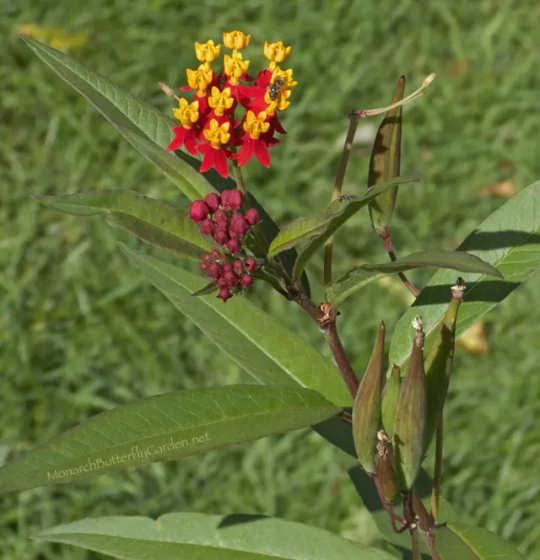
Step Two: Cut back seed pods! You would not believe how many seed pods milkweed makes. You see those little green footballs? You wanna snip these back ASAP. Even if they're tiny, but especially if they're bit. In peak flower production times, I'll go out there at least once a week and just do a look-back and cut them off. You can even yoink them off with your hands if you're in a rush--just don't get that sap into your eyes. If you do this, you're stopping seed production in its tracks--and don't forget, these plants want nothing more than to split those pods open and unleash a hellfire of flying seeds all over the place. They'll float on air, they'll float on water, they'll do whatever until they land on a prime patch of soil and get started.

If you see these you're a tinge too late. But also still yoink that off and Dispose of it.
Step 3: Don't give cuttings to your friends. It's tempting. If you're raising caterpillars in a little enclosure and see that every time you refresh your cuttings, the old ones have tons of roots and are ready for a little pot of soil and a name tag? Don't. Resist the best you can. Dispose of your cuttings whenever you go in for a trim.
Step 4: Consider replacing them with something else! I know I already went off about just how hard it was to find native milkweeds for sale, how expensive and difficult they can be to grow--but they're not impossible to grow, and putting in the effort could be worth it! Even as I speak, I'm trying to add as many native milkweeds to my garden as possible--and when I've got something that grows reliably in my backyard, I will eagerly rip up my aging tropical milkweed plants and promptly toss them in the bin so i can put a new, better milkweed in its place. Native milkweeds are more likely to be suited to your environment, making it easier to maintain and more welcoming to the pollinators we gardeners want to help. Not to mention, a lot of them are way pettier than tropical milkweed (in my opinion). Do some hunting online to see what's native to your area--your state's extensions office will likely be great for this! You've likely got great variety--the state of Florida has 21 native milkweeds! Who knows how many your state has! (Not me, I am Floridian, and I am already getting dizzy trying to learn about all 21 of our milkweeds).
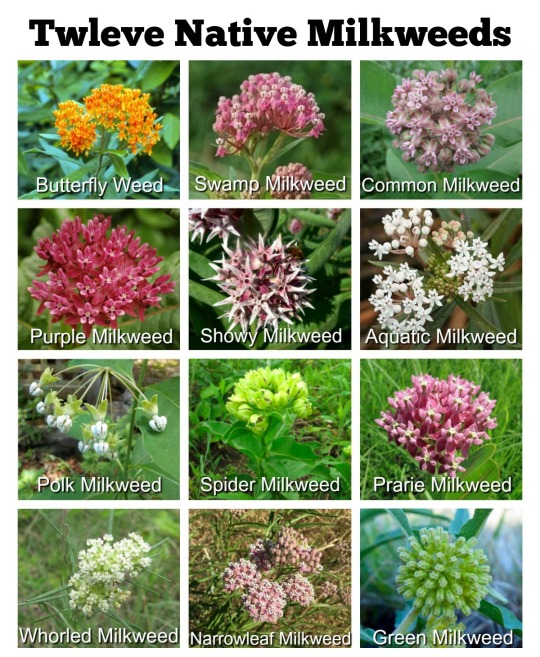
Conclusion!
Anyone who knows me knows I'm not gonna be the one to discourage someone from starting a garden, especially a pollinator gardener, and especially growing milkweed. But avoid tropical milkweed when you can--the harms it can cause far outweigh the quick satisfaction of a busy garden it can bring. Take some time to select a native plant more suited to your area, give it some friends and some time, and soon you'll have an amazing pollinator garden that'll be teeming with life!
#milkweed#tropical milkweed#asclepias curassavica#asclepias#outdoor gardening#succulents#bloodflower#pollinator garden#pollinator gardening#monarch butterfly#ani rambles#out of queue#what was it three hours ago that I was declaring that I wasn't gonna write up a long research post again?#now here i am at 3:30 am ranting about milkweed with like a dozen sources#granted this is nowhere NEAR as long as the biodiversity saga was BUT STILL#i told myself i was gonna write today... i meant one of my novels NOT RANTING ABOUT MILKWEED#if this post blows up this is gonna go on my wall of 'posts that i thought of on the toilet that got way more popular than I expected'#there's not a lot of posts on that wall maybe 2 or 3 but its weird that its happened that many times already
278 notes
·
View notes
Text
btw did you guys know that as many as 10% of all flowering plants species produce latex? everything from small flowers to trees (there's actually a tree known as the rubber tree because of this and. that is giving me Ideas) and most natural latex is a milky white as commonly seen in milkweeds, but also comes in yellow, orange and even scarlet in some plants and also it's mostly a defensive function, and when a plant is injured the latex is actively sent to the affected area, it's pretty neat!
12 notes
·
View notes
Text
Warrior Cats Prefixes- M
I had a WC Name Generator on Perchance that I made but I don't seem to have access anymore, so I'm remaking it here as just a simple list. The definitions used are the ones that Clan cats have for those things, and thus are the origins of the names. Definitions used are whatever I found when I googled it.
Maggot-: "[noun] a soft-bodied legless larva, especially that of a fly found in decaying matter"
Magnolia-: "[noun] a tree or shrub with large, typically creamy-pink, waxy flowers"
Magpie-: "[noun] a long-tailed crow with boldly marked (or green) plumage and a raucous voice; [noun] used in similes or comparisons to refer to a person who collects things, especially things of little use or value, or a person who chatters idly"
Mallard-: "[noun] the most common duck of the northern hemisphere and the ancestor of most domestic ducks, the male having a dark green head and white collar"
Mallow-: "[noun] a herbaceous plant with hairy stems, pink or purple flowers, and disk-shaped fruit"
Mantis-: "[noun] a slender predatory insect related to the cockroach. It waits motionless for prey with its large spiky forelegs folded like hands in prayer"
Maple-: "[noun] tree or shrub with lobed leaves, winged fruits, and colorful autumn foliage"
Marble-: "[noun] a hard crystalline metamorphic form of limestone, typically white with mottlings or streaks of color"
Marbled-: "[adj] having a streaked and patterned appearance like that of variegated marble"
Marigold-: "[noun] a plant of the daisy family, typically with yellow, orange, or copper-brown flowers"
Marrow-: "[noun] a soft fatty substance in the cavities of bones"
Marsh-: "[noun] an area of low-lying land which is flooded in wet seasons or at high tide, and typically remains waterlogged at all times"
Marten-: "[noun] a chiefly arboreal weasel-like mammal found in Eurasia and North America"
Matted-: "[adj] (especially of hair or fur) tangled into a thick mass"
Mayflower-: "[noun] a name given to several plants that bloom in May, especially certain hepaticas and anemones and the trailing arbutus"
Mayfly-: "[noun] a short-lived, slender insect with delicate, transparent wings and two or three long filaments on the tail that lives close to water"
Mayhaw-: "[noun] a hawthorn (Crataegus aestivalis) of the southern U.S. that bears a juicy scarlet acid frui"
Mazegill-: "[noun] a species of mushroom in the order Polyporales, and the type species of the genus Daedalea. Commonly known as the oak mazegill or maze-gill fungus, the specific epithet refers to the oak genus Quercus, upon which it frequently grows, causing a brown rot"
Mazzard-: "[noun] a cherry tree native to both Eurasia and North America, commercially important for both its fruit and wood"
Meadow-: "[noun] a piece of grassland; [noun] a piece of low ground near a river"
Meadowlark-: "[noun] a ground-dwelling songbird of the American blackbird family, with a brown streaky back and yellow and black underparts"
Melancholy-: "[noun] a feeling of pensive sadness, typically with no obvious cause]
Melody-: "[noun] sequence of single notes that is musically satisfying"
Melting-: "[adj] becoming liquefied by heat; [verb] the action or process of liquefying due to heat"
Merlin-: "[noun] a small dark falcon that hunts small birds, found throughout most of Eurasia and much of North America"
Midge-: "[noun] a small two-winged fly that is often seen in swarms near water or marshy areas where it breeds"
Midnight-: "[noun] the middle period of the night"
Milk-: "[noun] an opaque white fluid rich in fat and protein, secreted by female mammals for the nourishment of their young"
Milkcap-: "[noun] a species of mushroom characterized by the milky fluid they exude when cut or damaged"
Milkweed-: "[noun] a herbaceous American plant with milky sap. Some kinds attract butterflies, some yield a variety of useful products, and some are grown as ornamentals"
Milky-: "[adj] resembling milk in color"
Millipede-: "[noun] a myriapod invertebrate with an elongated body composed of many segments, most of which bear two pairs of legs. Most kinds are herbivorous and shun light, living in the soil or under stones and logs"
Mimic-: "[verb] imitate (someone or their actions or words); [noun] a cat skilled in imitating the voice, mannerisms, or movements of others"
Mink-: "[noun] a small semiaquatic carnivore resembling the stoat, native to North America and Eurasia"
Minnow-: "[noun] small freshwater Eurasian cyprinoid fish that typically forms large shoals"
Mint-: "[noun] an aromatic plant native to temperate regions of the Old World"
Mire-: "[noun] a stretch of swampy or boggy ground"
Mist-: "[noun] a cloud of tiny water droplets suspended in the atmosphere at or near the earth's surface that limits visibility"
Mistle-: "[noun] a bird common to much of Europe, temperate Asia and North Africa"
Mistletoe-: "[noun] a leathery-leaved parasitic plant which grows on apple, oak, and other broadleaf trees and bears white glutinous berries in winter"
Misty-: "[adj] full of, covered with, or accompanied by mist; [adj] indistinct or dim in outline"
Mite-: "[noun] a minute arachnid which has four pairs of legs when adult, related to ticks"
Mockingbird-: "[noun] a long-tailed songbird with grayish plumage, found mainly in tropical America and noted for its mimicry of the calls and songs of other birds"
Mold-: "[noun] a superficial often woolly growth produced especially on damp or decaying organic matter or on living organisms by a fungus; [noun] a fungus that produces mold"
Mole-: "[noun] a small burrowing insectivorous mammal with dark velvety fur, a long muzzle, and very small eyes"
Moon-: "[noun] the natural satellite of the earth, visible (chiefly at night) by reflected light from the sun"
Moor-: "[noun] a tract of open uncultivated upland; a heath"
Moorhen-: "[noun] a small aquatic rail with mainly blackish plumage"
Moose-: "[noun] a large deer with palmate antlers, a sloping back, and a growth of skin hanging from the neck"
Morel-: "[noun] a widely distributed edible fungus which has a brown oval or pointed fruiting body with an irregular honeycombed surface bearing the spores"
Morning-: "[noun] the period of time between midnight and noon, especially from sunrise to noon"
Moss-: "[noun] a small flowerless green plant that lacks true roots, growing in damp habitats and reproducing by means of spores released from stalked capsules; [noun] a green color like that of moss"
Mossy-: "[adj] resembling moss; [adj] covered with moss or something like moss"
Mosquito-: "[noun] a slender long-legged fly with aquatic larvae. The females consume blood"
Moth-: "[noun] a chiefly nocturnal insect related to butterflies. It lacks the clubbed antennae of butterflies and typically has a stout body, drab coloration, and wings that fold flat when resting"
Mottled-: "[adj] marked with spots or smears of color"
Mottlegill-: "[noun] a genus of small, black-spored, saprotrophic agarics with spotted gills"
Mountain-: "[noun] a large natural elevation of the earth's surface rising abruptly from the surrounding level"
Mouse-: "[noun] a small rodent that typically has a pointed snout, relatively large ears and eyes, and a long tail"
Mud-: "[noun] soft, sticky matter resulting from the mixing of earth and water"
Muddy-: "[adj] covered in or full of mud"
Mulberry-: "[noun] a small deciduous tree with broad leaves; [noun] a dark red or purple color"
Mullein-: "[noun] a herbaceous plant of the figwort family with woolly leaves and tall spikes of yellow flowers, native to Eurasia"
Mumble-: "[verb] say something indistinctly and quietly, making it difficult for others to hear; [noun] a quiet and indistinct utterance"
Murk-: "[noun] darkness or thick mist that makes it difficult to see"
Murky-: "[adj] dark and gloomy, especially due to thick mist; [adj] (of liquid) dark and dirty, not clear"
Mushroom-: "[noun] a fungal growth that typically takes the form of a domed cap on a stalk, with gills on the underside of the cap"
Myrtle-: "[noun] an evergreen shrub which has glossy aromatic foliage and white flowers followed by purple-black oval berries"
2 notes
·
View notes